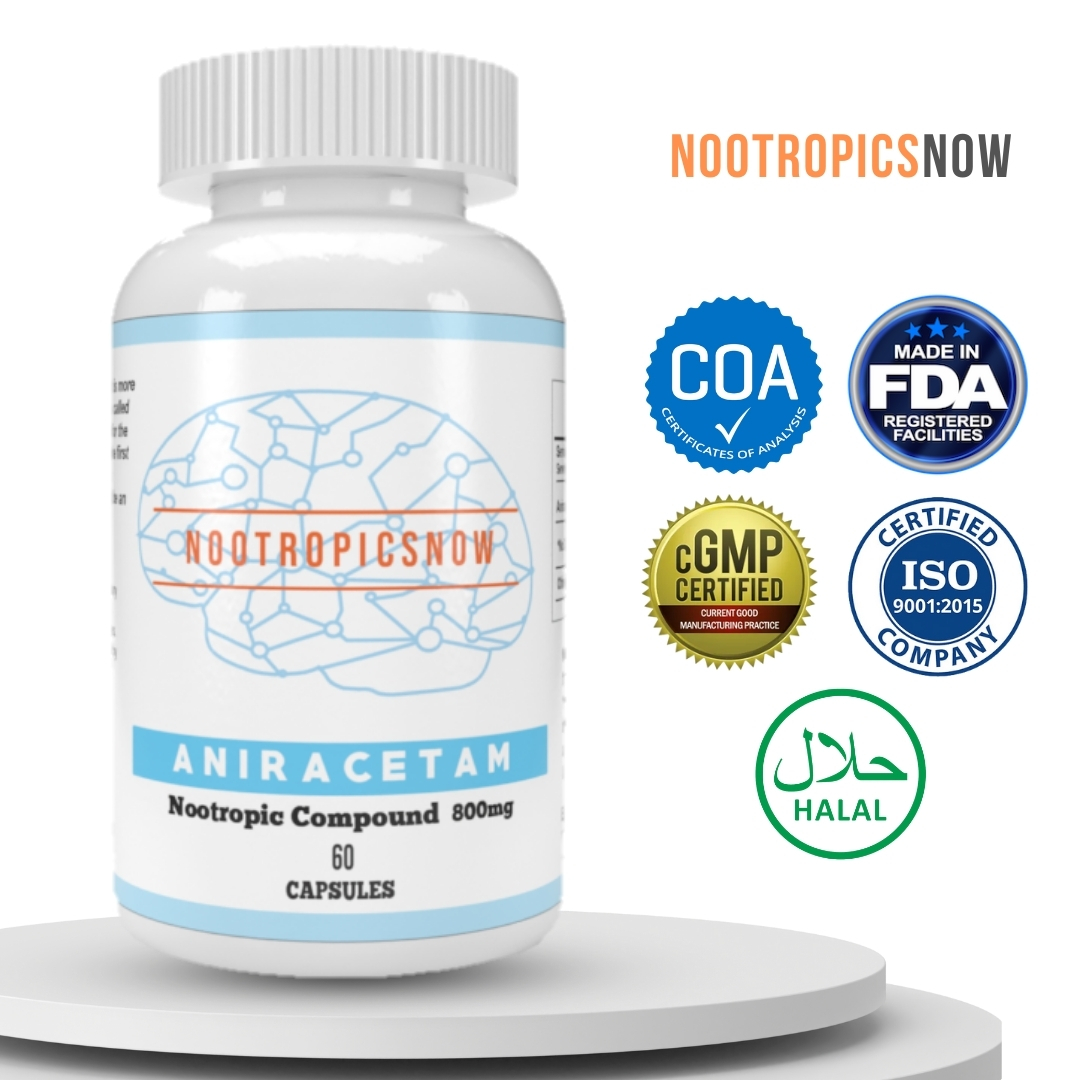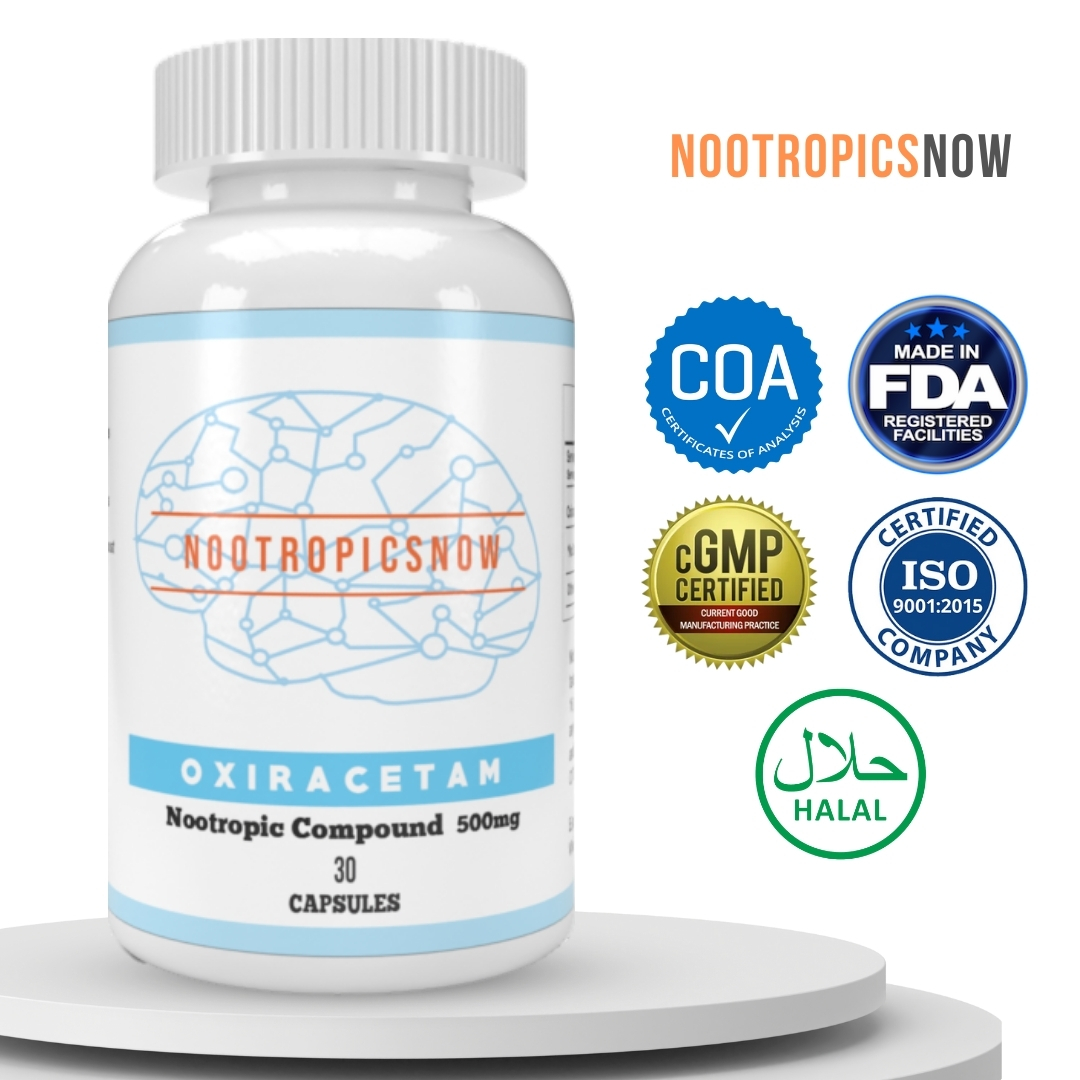Aniracetam: Benefits, Dosage & Side Effects

`markdown
Aniracetam: A Comprehensive Guide
Understanding Aniracetam: A Nootropic Overview
Aniracetam is a synthetic nootropic belonging to the racetam family, chemically related to piracetam. Developed in the 1970s by Hoffmann-La Roche, it quickly gained attention for its purported cognitive-enhancing properties. This compound is known for its potential to improve memory, focus, and learning capabilities, making it a subject of interest in the field of cognitive enhancement. However, understanding its mechanisms, benefits, risks, and legal status is crucial for anyone considering its use.
Aniracetam differs from its parent compound, piracetam, primarily in its increased potency and fat solubility. Consequently, aniracetam crosses the blood-brain barrier more effectively, potentially leading to more pronounced effects at lower dosages. While piracetam is water-soluble, the enhanced lipophilicity of aniracetam necessitates its intake alongside dietary fats for optimal absorption and bioavailability. Its unique properties distinguish aniracetam from other racetams.
Chemical Structure and Properties
Aniracetam’s chemical name is 1-p-anisoyl-2-pyrrolidinone, and its molecular formula is C12H13NO3. This signifies a structure featuring a pyrrolidinone ring attached to an anisoyl group. The presence of the anisoyl moiety significantly increases its lipid solubility. This increased solubility contributes to its ability to permeate cell membranes more readily compared to more polar racetams like piracetam.
The compound’s melting point typically ranges from 121-123°C, indicating its crystalline nature at room temperature. It appears as a white or off-white powder, which is a common presentation for nootropic compounds intended for oral administration. Understanding its basic chemical characteristics is foundational for examining its effects on brain function.
Aniracetam vs. Other Racetams
Racetams, as a class of nootropics, share a similar pyrrolidone core but vary in their substituent groups, which dictate their specific properties and mechanisms of action. Compared to piracetam, aniracetam is estimated to be significantly more potent, requiring smaller doses to achieve comparable effects. Other racetams, such as oxiracetam and pramiracetam, each have their own unique profiles in terms of cognitive effects and stimulant properties.
Oxiracetam, for example, is known for its purported stimulating and focus-enhancing effects, while pramiracetam is known for its high potency and purported cognitive benefits. Aniracetam distinguishes itself by being associated with both cognitive enhancement and anxiolytic (anxiety-reducing) effects. However, it’s important to note that the effects of these compounds are highly subjective and can vary significantly among individuals.
Mechanisms of Action: How Aniracetam Works
Aniracetam’s cognitive-enhancing effects are attributed to its complex interactions with various neurotransmitter systems in the brain. While the exact mechanisms are still being researched, several key pathways are believed to play a crucial role.
Modulation of Acetylcholine
One of the primary mechanisms of action for aniracetam involves the cholinergic system, specifically the neurotransmitter acetylcholine. Aniracetam has been shown to enhance the release of acetylcholine and improve its utilization in the brain. This enhancement is achieved through the allosteric modulation of acetylcholine receptors, specifically the muscarinic acetylcholine receptors. By increasing the efficiency of cholinergic neurotransmission, aniracetam can improve memory, learning, and overall cognitive function.
Furthermore, aniracetam is thought to interact with the high-affinity choline uptake system, facilitating the transport of choline into neurons for acetylcholine synthesis. Thus, aniracetam not only promotes the release of acetylcholine but also ensures an adequate supply of its precursor. This dual action supports cholinergic function and contributes to cognitive enhancement.
Impact on Glutamate Receptors
Beyond its cholinergic effects, aniracetam also influences the glutamatergic system, which is crucial for synaptic plasticity and long-term potentiation (LTP). LTP is a cellular mechanism underlying learning and memory formation. Aniracetam acts as a positive allosteric modulator of AMPA receptors, a subtype of glutamate receptors. By enhancing AMPA receptor activity, aniracetam increases the strength of synaptic connections and promotes LTP.
This modulation of AMPA receptors is believed to contribute to aniracetam’s ability to improve cognitive flexibility and enhance learning. The improved glutamatergic neurotransmission can also lead to heightened mental clarity and improved information processing. Thus, aniracetam’s dual action on both cholinergic and glutamatergic systems synergistically supports cognitive enhancement.
Anxiolytic and Mood-Enhancing Effects
Aniracetam also exhibits anxiolytic (anxiety-reducing) and mood-enhancing effects, which may be mediated through its interactions with other neurotransmitter systems. Studies suggest that aniracetam can influence the levels of dopamine and serotonin, two neurotransmitters closely associated with mood regulation and emotional well-being.
While the precise mechanisms are still being investigated, aniracetam is believed to modulate the release and reuptake of these neurotransmitters, contributing to its anxiolytic and mood-enhancing properties. These effects can further enhance cognitive function by reducing stress and improving overall mental state.

View Product
The calming effect induced by aniracetam may promote a state of relaxed focus, thereby optimizing cognitive performance.
Effects on Brain Metabolism
Aniracetam also affects brain metabolism by enhancing cerebral blood flow and energy utilization. Specifically, studies indicate that aniracetam improves glucose metabolism in the brain, providing neurons with increased energy to perform cognitive tasks. This enhanced energy metabolism can contribute to improved mental endurance and reduced mental fatigue.
Moreover, the enhanced cerebral blood flow ensures that neurons receive an adequate supply of oxygen and nutrients, further supporting their function. The combined effects of improved energy metabolism and enhanced cerebral blood flow contribute to aniracetam’s overall cognitive-enhancing properties. These effects are particularly beneficial for individuals experiencing age-related cognitive decline or those engaged in mentally demanding activities.
Cognitive Benefits of Aniracetam: What to Expect
Aniracetam is primarily used for its potential cognitive-enhancing effects. Users report a range of benefits, including improved memory, enhanced focus, and increased learning capacity. However, it’s essential to understand that individual experiences can vary, and the effects of aniracetam may depend on factors such as dosage, individual physiology, and pre-existing cognitive function.
Memory Enhancement
One of the most commonly reported benefits of aniracetam is improved memory. Users often report an enhanced ability to recall information, both short-term and long-term. This memory enhancement may be particularly beneficial for students, professionals, and individuals experiencing age-related memory decline.
The improvement in memory is likely due to aniracetam’s effects on the cholinergic and glutamatergic systems, both of which play crucial roles in memory formation and retrieval. By enhancing acetylcholine release and modulating AMPA receptors, aniracetam can strengthen synaptic connections and improve the efficiency of memory processes.
Improved Focus and Concentration
Aniracetam is also known for its potential to improve focus and concentration. Users report an increased ability to maintain attention and stay on task, which can be particularly beneficial for individuals with attention deficits or those engaged in tasks requiring sustained mental effort.

View Product
The improvement in focus may be related to aniracetam’s effects on dopamine and other neurotransmitters involved in attention regulation. By modulating these systems, aniracetam can promote a state of heightened alertness and mental clarity, allowing for improved focus and concentration.
Enhanced Learning Capacity
Another reported benefit of aniracetam is an enhanced learning capacity. Users report an increased ability to acquire new information and skills, which can be particularly beneficial for students and professionals in fields requiring continuous learning. The enhanced learning capacity is likely due to aniracetam’s effects on synaptic plasticity and long-term potentiation (LTP), which are crucial for learning and memory formation.
By strengthening synaptic connections and promoting LTP, aniracetam can improve the efficiency of learning processes and facilitate the acquisition of new knowledge and skills. This can lead to improved academic performance, enhanced professional capabilities, and increased overall cognitive function.
Anxiolytic and Mood-Boosting Effects
In addition to its cognitive-enhancing properties, aniracetam also exhibits anxiolytic and mood-boosting effects. Users report a reduction in anxiety, stress, and overall mood improvement. These effects may be particularly beneficial for individuals experiencing stress-related cognitive impairment or those with mood disorders.

View Product
The anxiolytic and mood-boosting effects of aniracetam are likely due to its interactions with dopamine and serotonin systems, which play crucial roles in mood regulation and emotional well-being. By modulating these neurotransmitter systems, aniracetam can promote a sense of calm and well-being, leading to improved overall mood and cognitive function.
Increased Creativity and Cognitive Flexibility
Some users also report increased creativity and cognitive flexibility after taking aniracetam. This may be due to its capacity to improve communication between the brain’s hemispheres and modulate the glutamate system. This effect may be especially helpful for tasks requiring innovative problem-solving and abstract thinking.
Sensory Enhancement
Anecdotal reports suggest aniracetam may heighten sensory perceptions, like visual and auditory processing. Colors may appear more vivid, sounds more pronounced, and overall sensory experiences more intense. While not thoroughly studied, this property could influence creativity and appreciation of art or music.
Dosage and Administration: How to Use Aniracetam
The appropriate dosage and administration of aniracetam are crucial for achieving optimal effects and minimizing potential side effects. Individual responses can vary significantly, so it’s essential to start with a low dose and gradually increase it as needed.
Recommended Dosage Range
The typical dosage range for aniracetam is between 750 mg and 1500 mg per day, divided into two or three doses. Some users may find that lower doses are sufficient, while others may require higher doses to achieve the desired effects. However, exceeding the recommended dosage is generally not advisable, as it may increase the risk of side effects without necessarily providing additional cognitive benefits.
Timing and Frequency of Doses
Aniracetam is fat-soluble, so it’s best taken with meals containing healthy fats to improve absorption. The timing and frequency of doses can also affect its efficacy. Some users prefer to take aniracetam in the morning and early afternoon to avoid potential sleep disturbances, while others may find that taking a dose in the late afternoon or evening is beneficial for maintaining focus and concentration throughout the day.
Dividing the daily dose into two or three smaller doses can help maintain a more stable concentration of aniracetam in the bloodstream, which may lead to more consistent cognitive benefits. Experimenting with different dosing schedules can help you find the timing and frequency that works best for your individual needs.
Cycling Aniracetam
Some users advocate for cycling aniracetam, which involves taking it for a specific period followed by a break. This approach is believed to prevent tolerance from developing and to maintain its effectiveness over time. Common cycling schedules include taking aniracetam for several weeks or months, followed by a break of equal length. However, there is limited scientific evidence to support the effectiveness of cycling aniracetam, and individual responses may vary.
Methods of Administration
Aniracetam is usually taken orally. Capsules and powder are the two most common forms available for purchase. Capsules are easier for precise dosing; however, powder may be more economical. Sublingual administration, placing the powder under the tongue, may result in a faster onset of effects, but it is not a typical method.
Stacking with Other Nootropics
Stacking involves combining two or more nootropics to enhance cognitive effects. Some popular stacks include aniracetam with choline sources like Alpha-GPC or citicoline. Choline supplementation may help mitigate headaches that can occur with racetams. Aniracetam is often stacked with other racetams to create synergistic benefits.
Safety and Side Effects: What to Watch Out For
Aniracetam is generally considered safe when taken at recommended dosages. However, like any nootropic compound, it can cause side effects in some individuals. It’s essential to be aware of potential side effects and take appropriate precautions to minimize risks.
Common Side Effects
The most commonly reported side effects of aniracetam include headaches, anxiety, nausea, and insomnia. These side effects are generally mild and transient, and they often subside with continued use or a reduction in dosage. Headaches, in particular, are a relatively common side effect of racetams, including aniracetam. This is believed to be due to increased acetylcholine utilization, which can deplete choline levels in the brain.

View Product
Supplementing with a choline source, such as Alpha-GPC or citicoline, can often alleviate these headaches. Anxiety, nausea, and insomnia are less common side effects, but they can occur in some individuals. These side effects may be related to aniracetam’s effects on dopamine and serotonin systems, or they may be due to individual sensitivity to the compound.
Less Common Side Effects
In rare cases, aniracetam can cause more severe side effects, such as allergic reactions, liver toxicity, and cognitive impairment. These side effects are generally very rare, but they can occur in susceptible individuals. Allergic reactions can manifest as skin rashes, itching, or difficulty breathing. Liver toxicity can cause jaundice, abdominal pain, and elevated liver enzymes. Cognitive impairment can manifest as confusion, memory loss, or difficulty concentrating.
If you experience any of these severe side effects, discontinue use of aniracetam and seek medical attention immediately. It’s important to note that aniracetam may interact with other medications and supplements, potentially increasing the risk of side effects. Therefore, it’s crucial to inform your doctor about any medications or supplements you are taking before starting aniracetam.
Contraindications
Aniracetam is not recommended for individuals with certain medical conditions, such as liver disease, kidney disease, or bleeding disorders. It’s also not recommended for pregnant or breastfeeding women, as its safety in these populations has not been established. Individuals with a known hypersensitivity to racetams should also avoid aniracetam.
Aniracetam may also interact with anticoagulant medications, increasing the risk of bleeding. It’s also important to note that aniracetam may affect blood sugar levels, so individuals with diabetes should monitor their blood sugar closely when taking aniracetam.
Long-Term Safety
The long-term safety of aniracetam has not been extensively studied in humans. However, based on available data and clinical experience, aniracetam appears to be relatively safe for long-term use when taken at recommended dosages. However, it’s still essential to monitor for potential side effects and to discontinue use if any adverse effects occur.
Animal studies have shown that long-term administration of aniracetam can lead to tolerance, meaning that higher doses are needed to achieve the same effects. Therefore, cycling aniracetam may be a reasonable approach to prevent tolerance from developing.
Legal Status and Availability: Where to Find Aniracetam
The legal status and availability of aniracetam vary depending on the country. In some countries, aniracetam is available as a prescription medication, while in others, it’s available as an over-the-counter supplement. In the United States, aniracetam is sold as a dietary supplement, but it’s not approved by the FDA for the treatment of any medical condition.
United States
In the United States, aniracetam is legally available as a dietary supplement. However, it’s important to note that the FDA does not regulate the quality, safety, or efficacy of dietary supplements, so it’s essential to purchase aniracetam from reputable suppliers that adhere to strict quality control standards.

View Product
Consumers should look for third-party testing and certifications to ensure product purity and potency.
Europe
The legal status of aniracetam in Europe varies depending on the country. In some countries, such as Greece and Italy, aniracetam is available as a prescription medication for the treatment of cognitive disorders. In other countries, it may be available as an over-the-counter supplement or may not be legally available at all.
Australia
In Australia, aniracetam is classified as a Schedule 4 substance, meaning it’s available only with a prescription from a medical practitioner. This classification restricts its use to individuals who have been diagnosed with a medical condition that warrants its use.
Benefits of Aniracetam
Aniracetam offers a range of cognitive benefits, making it a popular choice among nootropic users. It is crucial to understand these potential benefits, although individual responses can vary considerably.
It is important to note that, while these benefits are reported by many users and supported by some research, individual results can vary. Factors such as dosage, individual biochemistry, and lifestyle can influence the effects of Aniracetam.
Aniracetam Dosage and Administration
Proper dosage and administration are essential for maximizing the benefits of Aniracetam while minimizing potential side effects. The optimal dosage can vary based on individual factors and the specific goals of the user.
Individual responses to Aniracetam can vary. Close monitoring of effects and adjustments to dosage as needed will help one dial in their most effective protocol.
Aniracetam Side Effects and Safety
Like all substances, Aniracetam can cause side effects in some individuals. Understanding the potential side effects and safety considerations is crucial for using Aniracetam responsibly.
While Aniracetam is generally considered safe for most people, it is essential to be aware of the potential side effects and take necessary precautions to minimize risks. Individual responses can vary, so monitoring effects is recommended.
Aniracetam Stacks and Combinations
Many nootropic users explore stacking Aniracetam with other compounds to enhance its effects or address potential side effects. Combining substances can amplify cognitive benefits, but it also requires careful consideration to ensure safety and efficacy.
Careful planning and monitoring are crucial when combining Aniracetam with other nootropics or supplements. Understanding the interactions and potential benefits of each compound will help you create an effective and safe stack.
Aniracetam Reviews and User Experiences
User experiences with Aniracetam vary widely, reflecting individual differences in biochemistry, lifestyle, and expectations. Examining reviews and anecdotal reports can provide valuable insights into the potential effects and considerations for using this nootropic.
Reviewing user experiences can provide a broader understanding of the potential benefits and drawbacks of Aniracetam. While anecdotal reports should not replace scientific evidence, they can offer valuable insights into how individuals respond to this nootropic and guide responsible use.
Purchasing Aniracetam
When considering purchasing Aniracetam, it’s important to be aware of legal regulations and to select reliable vendors. Availability and regulations vary by country, and choosing reputable sources ensures product quality and safety.
Purchasing Aniracetam requires careful consideration of legal regulations and vendor selection. Choosing reputable sources and verifying product quality through third-party testing ensures you receive a safe and effective product. Awareness of the legal landscape allows you to make informed decisions and comply with local regulations.







